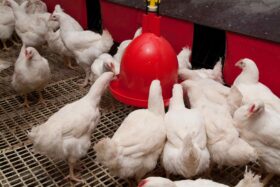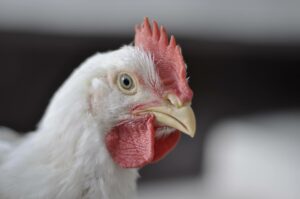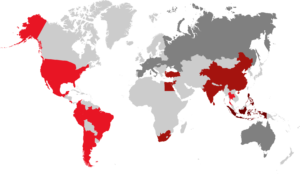By Dr. Inge Heinzl, EW Nutrition
The liver is one of the most active organs within the avian body. Without the liver, the brain would not work, for example. Whenever glucose is not readily available for energy, the brain relies on ketone bodies provided by the liver. The liver also transforms and detoxifies substances foreign to the body (e.g., coccidiostats) and plays a role in immune defense. But how does the liver metabolism function exactly? Find out why it is so important to protect this crucial organ.

5 ways the liver keep the avian body running
The liver fulfills various essential functions. The avian liver:
- Provides the ‘fuel’ for all organs
- Supplies the body with essential substances
- Acts as a storage organ
- Is part of the immune defense
- Supports the detoxification of the body
1. The liver provides the ‘fuel’ for organs
The brain, the muscle, the different organs of the body – all need energy to function. This fuel is provided by the liver. And it caters to different preferences, too: the different organs need different substances as fuel. The brain usually uses glucose and, in the case of necessity (hunger), ketone bodies. Skeletal muscles work with glucose and, if glucose is lacking, fatty acids for energy generation. Heart and liver gain energy through the ß-oxidation of fatty acids.
The liver adapts to different situations
After they arrive in the gut, most of the nutrients are transported from the small intestine via the portal vein to the liver. There, they are further processed. Regardless of the nutritional supply, the liver must continuously provide energy for the other organs. In the following, different situations of energy availability are described.
1. Just after feed intake
After feed intake, there is enough energy to be metabolized. Glucose then is further processed as follows:
- Part of the glucose directly serves as ‘fuel’ for different organs
- Another part is transformed into glycogen by the liver and stored in situ (glycogen is a storage substance that can be easy retransformed into glucose)
- Some glucose is metabolized into acetyl coenzyme A (acetyl-CoA), which can be used to synthesize fatty acids. Fatty acids’ esterification with glycerol, in turn, results in the production of triglycerides. The liver can also synthesize triglycerides from lactate. The lactate comes from the muscles or the mucosa cells. In mammals, lipid tissue is the primary place for triglyceride synthesis. In contrast, in poultry, the “de novo lipogenesis” site is the liver (Stevens, 2004). These triglycerides are subsequently:
- stored within the hepatocytes
- transported as “very-low-density lipoproteins” (VLDLs), a water-soluble transport form, in the blood to other organs or the adipose tissue, or
- used for energy generation or as an energy store in the other organs or adipose tissue.
Insulin is involved in these actions, promoting the synthesis of fatty acids out of carbohydrates as well as the synthesis of VLDLs.

Figure 1: The role of the liver in the fed state [Zaefarian et al., 2019, Hermier, 1997]
2. Between meals – the blood glucose level decreases
Some time has passed since the last feed intake; glucose has been transported from the blood to the cells. However, the organs continue to need energy, which has to be released continuously from the organs in which it is stored:
- In the liver and the kidneys, the stored glycogen must be broken down into glucose, triggered by the hormone glucagon
- In the skeletal muscles, glycogen is metabolized aerobically to CO2 and H2O or anaerobically to lactate
- The liver uses lactate for gluconeogenesis, stimulated by free fatty acids released from the degradation of depot fat

Figure 2: The role of the liver in the state of decreasing energy [Braun and Sweazea, 2008; Sturkie, 2012; Stevens, 2004]
3. Starvation – reserves are depleted
If the glycogen reserve in the liver is depleted after some hours since the last feed intake, fatty acids are degraded to ketone bodies in the skeletal muscles. In parallel, protein degradation frees up glucogenic amino acids that the liver can use for gluconeogenesis. The lactate from the anaerobe degradation of glucose in the skeletal muscles and glycerol can also be used for gluconeogenesis. In mammals, pyruvate is the best substrate for gluconeogenesis; in poultry, it is lactate.
Gluconeogenesis also takes place in the kidneys. During starvation, 30% of the gluconeogenesis is done by the kidneys and 70% by the liver. Birds are generally able to sustain higher rates of gluconeogenesis than mammals (Stevens, 2004).
To meet the brain’s energy requirements, the liver transforms fatty acids into ketone bodies; they are the only source of energy the brain accepts besides glucose. Although the liver is the main site of ketone production, its ability to use them is limited.
During starvation, glycogen storage in the heart muscle increases. Glycogen levels in the heart muscle are usually relatively low (1.60-2.00 mg / g); in the case of starvation, these levels may triple within 48-92 hours (Hazelwood, 1976) – probably an effect of increased gluconeogenesis.

Figure 3: The role of the liver in the state of starvation [Frias-Soler et al., 2021; Braun and Sweazea, 2008; Sturkie, 2012]
The efficiency of glucose utilization changes
Depending on the catabolic pathway, the efficiency of glucose utilization varies considerably. Moreover, the age or development of the body is a decisive factor. Table 1 shows the variation in glucose utilization depending on age. In all cases, the efficiency of glucose utilization increases with age. However, the efficiency of lipogenesis increases most, which is one reason why older animals tend to get fat.
Table 1: Utilization of glucose for glycolysis (energy generation), glycogenesis (storage), and lipogenesis (storage) in gallus gallus, based on Scanes, 2015
| Age (days) | Glucose utilization1 (as a percentage of plateau level) | ||
| Glycolysis2 | Glycogenesis | Lipogenesis | |
| Late embryo and day 0 | 13.3 ± 0 | ˂ 0.5 | < 0.5 |
| 2 | 51.1 ± 6.4 | 10.0 ± 4.1 | 4.0 ± 1,0 |
| 4 | 85.4 ± 5.5 | 8.3 ± 0 | 36.8 ± 9.8 |
| 8 | 104.4 ± 4.6 | 7.6 ± 1.1 | 94.7 ± 14.7 |
| 12 | 84.5 ±10.5 | 34.8 ± 9.4 | 66.8 ± 10.4 |
| 16 | 120.8 ± 12.5 | 105.1 ± 24.5 | 144.2 ± 29.0 |
1Determined by utilization of [U _14 C] Glucose 2Plateau conversion to CO2: 1261 dpm/mg calculated from Goodridge (1968a)
Bold data are at plateau
2. The liver supplies the body with essential substances
The liver is involved in many processes in the organism. It takes part in protein synthesis, provides the building blocks for metabolic processes, and, hence, is essential for the body’s smooth functioning.
The liver produces various proteins
The liver is an important organ for protein synthesis. Most of the plasma proteins (90%) such as albumins, globulins (γ-globulins excluded) are produced by the liver. The liver also synthesizes transport proteins (e. g. for copper, retinol, iron), coagulation factors, and non-essential amino acids. For this purpose, amino acids, arriving from the gut via the portal vein, are transformed through deamination and transamination (Dhawale, 2007).
Cholesterol is an essential building block for further processing
The liver produces cholesterol, a building block for the production of bile, steroid hormones, and vitamin D. Cholesterol is also an essential ingredient of the cell membrane.
As a bile producer, the liver plays a significant role in digestion. In the gut, the bile emulsifies the dietary fats into small droplets, which then can be absorbed via the gut cells (enterocytes) into the body. The bile is also a transport medium for waste products, through delivery into the gut lumen (detoxification function).
The liver plays a prominent role in egg production
In poultry, the composition of the egg depends on the liver. Egg yolks consist of water (70%), proteins (10%), and lipids (20%). The yolk lipids are lipoproteins rich in triglycerides, built up in the liver and transported as egg yolk-specific VLDLs (VLDLy) to the ovary. Also, cholesterol is transported via lipoproteins to the egg yolk.
3. The liver acts as a storage organ
The liver is a storage organ for blood and glycogen (energy metabolism). Also, minerals (sodium) and trace elements such as copper, manganese, fluor, iodine, selenium, chlorine, and iron are retained. The liver has the highest participation in the Mn metabolism, and iron is accumulated as ferritin.
Vitamin A is stored in the highest concentrations after the transformation of carotin. The liver also accumulates vitamins D, K, B1, B12, C, riboflavin, pantothenic acid, nicotinic acid, folic acid, and biotin (Dhawale, 2007).
4. The liver is part of the immune defense
The liver filters the blood and, in this way, removes microorganisms (e.g., those originating from the gastrointestinal tract), toxins, and aged erythrocytes. For its immunological tasks, the liver has different types of immune-competent cells at its disposal. The so-called Kupffer cells are liver-specific macrophages descending from monocytes and belonging to the specific immune defense. They represent 80-90% of all tissue macrophages (Hinghofer-Szalkay, 2021).
In a healthy liver, the Kupffer cells can eliminate about 95% of the bacteria arriving through the blood. The main task of these cells is to ingest the enemies, process them, and surface parts of them as antigenic material. Besides the phagocytosis of bacteria, Kupffer cells can also incorporate toxins, immune complexes, parts of cells, and viruses. They excrete cytokines, provoking the production of acute-phase proteins (e.g., fibrinogen), fending off tumor cells and regulating the function of other liver cells. With the help of the Kupffer cells, the liver transforms or completely degrades toxins ingested with the feed (e.g., mycotoxins) (Zaefarian, 2019).
5. The liver supports the detoxification of the body
One example is nitrogen, a product of the protein metabolism that must be excreted in an energy-intensive process via the liver and the kidneys. Ammonia and keto acids are formed by deamination. As ammonia has a toxic effect in birds, it is transformed to uric acid, transported to the kidneys, and excreted from there.
The liver is also responsible for at least the partial conjugation of already used hormones (transformation into water-soluble substances), which are then excreted via the bile. Furthermore, it assists in the degradation of red blood cells. The Kupffer cells in the liver phagocytize (“eat”) overaged red blood cells. Reusable substances such as iron are kept, the useless residual is degraded and excreted (Hinghofer-Szalkay, 2021).
Poultry producers have to do their best to protect the liver
The liver fulfills critical tasks for the body, such as detoxification, immune defense participation, and energy management.
 For meat-producing animals, growth is a critical factor. The growth rate is determined by cell growth, which depends on the speed of cell division and the synthesis of protein in the liver and muscle cells. It furthermore depends on the production and secretion of growth-regulating hormones and related metabolism processes that also take place in the liver.
For meat-producing animals, growth is a critical factor. The growth rate is determined by cell growth, which depends on the speed of cell division and the synthesis of protein in the liver and muscle cells. It furthermore depends on the production and secretion of growth-regulating hormones and related metabolism processes that also take place in the liver.
Thus, to keep animals in good health and maintain high growth performance,the protection of the liver should be a top priority for the producer.
References
Dhawale, Avinash. “The Liver: a Big Organ with a Big Role.” World Poultry 23, no. 10 (November 23, 2007): 34–36.
Grashorn, M. “Eiqualität.” Essay. In Legehuhnzucht Und Eiererzeugung: Empfehlungen für Die Praxis Spec. issue 322, Spec. issue 322:19–33. Braunschweig, Germany: Johann Heinrich von Thünen-Institut, Bundesforschungsinstitut für Ländliche Raüme, Wald und Fischerei, 2009.
Hinghofer-Szalkay, H. “Eigenschaften Und Aufgaben Hepatischer Nichtparenchymzellen.” Physiologie nicht-parenchymale Leberzellen Funktion. Accessed December 21, 2021. http://physiologie.cc/III.3.htm.
Scanes, C. G. “Carbohydrate Metabolism.” Essay. In Sturkie’s Avian Physiology; 6th Ed., 443. London: Academic Press/Elsevier, 2015.
Scanes, C. G., and Paul D. Sturkie. “Adipose Tissue and Lipid Metabolism.” Essay. In Sturkie’s Avian Physiology ; 6th Ed., 443. London: Academic Press/Elsevier, 2015.
Stevens, Lewis. “Carbohydrate and Intermediary Metabolism.” Essay. In Avian Biochemistry and Molecular Biology, 3rd ed., 29–36. Cambridge <<>>: Cambridge Univ. Press, 2004.
Zaefarian, Faegheh, Mohammad Abdollahi, Aaron Cowieson, and Velmurugu Ravindran. “Avian Liver: The Forgotten Organ.” Animals 9, no. 2 (2019): 63. https://doi.org/10.3390/ani9020063.















